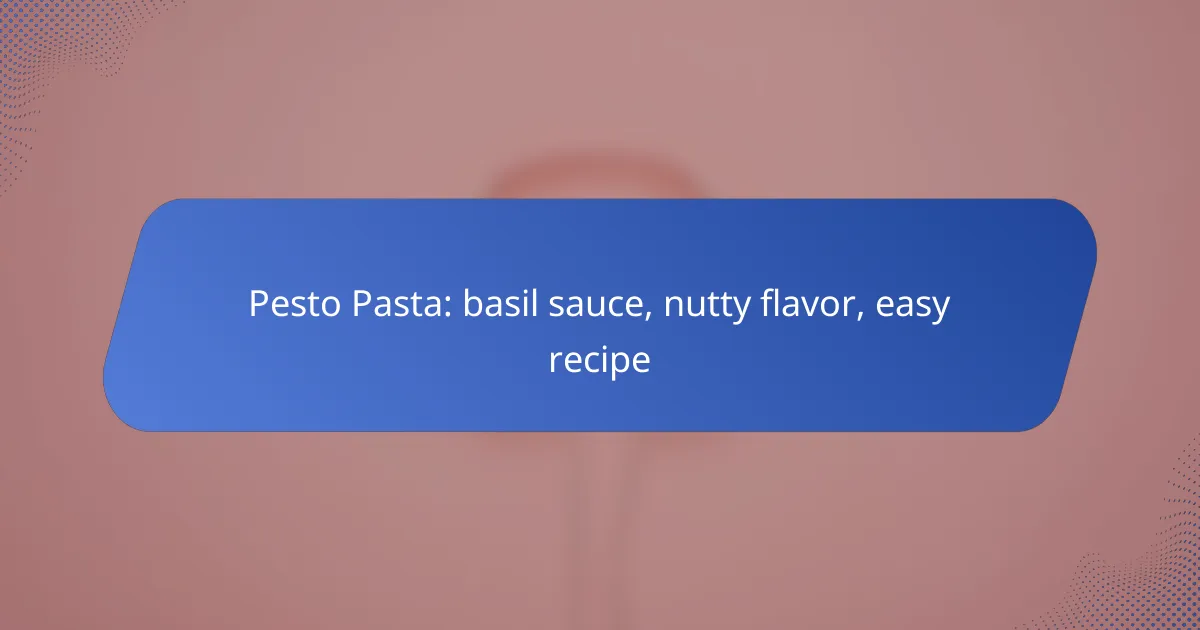Gnocchi, the beloved Italian potato dumplings, are known for their soft and pillowy texture, making them a delightful addition to any meal. Crafted from simple ingredients like potatoes and flour, these dumplings can be paired with a variety of sauces, from classic tomato to rich cream-based options, each enhancing their unique flavor. Whether enjoyed in upscale restaurants or casual eateries, gnocchi offers a comforting and versatile dining experience.

How to make gnocchi from scratch?
Making gnocchi from scratch involves combining simple ingredients like potatoes and flour to create soft, pillowy dumplings. The process requires careful handling to achieve the right texture and flavor, ensuring they pair well with various sauces.
Ingredients for homemade gnocchi
To make gnocchi, you will need a few basic ingredients: starchy potatoes, all-purpose flour, and an egg. Typically, around 1 kilogram of potatoes will require about 200-300 grams of flour and one egg to bind the mixture. Using starchy potatoes, like Russets, will yield the best results.
Optionally, you can add salt and nutmeg for enhanced flavor. Ensure the potatoes are cooked until tender, as this will affect the final texture of the gnocchi.
Step-by-step preparation process
Start by boiling the potatoes with their skins on until they are fork-tender, which usually takes about 30-40 minutes. Once cooked, peel them while still warm and mash them until smooth. Allow the mash to cool slightly before mixing in the flour and egg.
Form the mixture into a dough, being careful not to overwork it, as this can lead to tough gnocchi. Divide the dough into smaller portions, roll each into a rope, and cut into bite-sized pieces. Use a fork to create ridges on each piece, which helps sauces cling better.
Cooking techniques for perfect texture
To cook gnocchi, bring a large pot of salted water to a gentle boil. Add the gnocchi in batches, ensuring not to overcrowd the pot. They are ready when they float to the surface, usually within 2-4 minutes.
For a delightful texture, consider pan-frying the cooked gnocchi in a bit of butter or olive oil until golden brown. This adds a crispy exterior while keeping the inside soft. Avoid overcooking, as this can lead to a mushy texture.

What sauces pair well with gnocchi?
Gnocchi pairs well with a variety of sauces that enhance its soft texture and flavor. Popular options include classic tomato sauces, rich cream-based sauces, and herb-infused oils, each offering a unique taste experience.
Classic tomato sauce options
Classic tomato sauces are a staple pairing for gnocchi, providing a bright and tangy contrast to the dumplings. Marinara, arrabbiata, and pomodoro are popular choices that can be easily prepared at home or purchased pre-made.
When selecting a tomato sauce, consider the level of acidity and sweetness. A well-balanced sauce will complement the soft texture of gnocchi without overpowering it. For added flavor, incorporate fresh basil or oregano into the sauce.
Rich cream-based sauces
Cream-based sauces add a luxurious richness to gnocchi, making them a favorite for many. Options like Alfredo, gorgonzola, or a simple cream and parmesan sauce create a decadent dish that is both filling and satisfying.
When using cream sauces, keep the proportions in mind; a little goes a long way. Aim for a light coating rather than drowning the gnocchi, allowing the flavors to shine through. Adding sautéed mushrooms or spinach can enhance the dish further.
Herb-infused oil pairings
Herb-infused oils offer a lighter alternative to heavier sauces, providing a fresh and aromatic flavor profile. Olive oil infused with garlic, rosemary, or thyme can elevate the taste of gnocchi without overwhelming it.
To create your own herb-infused oil, simply heat olive oil gently with your choice of herbs, allowing the flavors to meld. Drizzle this oil over cooked gnocchi for a simple yet flavorful dish. Pairing with grated cheese or toasted nuts can add texture and depth to the meal.

Where to find the best gnocchi in New Zealand?
The best gnocchi in New Zealand can be found in a mix of upscale Italian restaurants, casual eateries, and local markets. These establishments offer a variety of potato dumplings, often paired with rich sauces that enhance their soft texture.
Top Italian restaurants in Auckland
Auckland boasts several renowned Italian restaurants known for their authentic gnocchi. Places like Osteria Bar & Eatery and La Porchetta serve homemade versions, often featuring seasonal ingredients and traditional sauces.
When dining out, look for specials that highlight gnocchi dishes, as these can showcase the chef’s creativity and the freshest local produce. Reservations are recommended, especially during weekends.
Popular eateries in Wellington
Wellington’s vibrant food scene includes popular spots like Floradale’s and Scopa, where gnocchi is a staple on the menu. These eateries often offer unique takes on the classic dish, incorporating local flavors and ingredients.
Consider visiting during lunch hours for a more relaxed experience, and keep an eye out for daily specials that may feature gnocchi paired with inventive sauces.
Local markets offering fresh gnocchi
Fresh gnocchi can also be found at various local markets across New Zealand. Markets such as the Victoria Street Market in Auckland and the Wellington Night Market often feature vendors selling homemade dumplings.
Shopping at these markets allows you to buy fresh gnocchi to cook at home, often at a lower price than dining out. Look for vendors who offer samples to ensure you find the perfect texture and flavor for your taste.

What are the nutritional benefits of gnocchi?
Gnocchi, primarily made from potatoes, offer several nutritional benefits, including carbohydrates for energy and some essential vitamins and minerals. While they are a comforting food, it’s important to consider portion sizes and the sauces used, as these can significantly affect their overall nutritional profile.
Caloric content and serving sizes
The caloric content of gnocchi can vary, but a typical serving of about 100 grams contains around 130 to 150 calories. When preparing gnocchi, consider that serving sizes can range from 100 to 200 grams, depending on whether it’s served as a main dish or a side. Pairing gnocchi with lighter sauces can help keep the meal balanced.
To manage caloric intake, be mindful of portion sizes and the ingredients used in sauces. Creamy or rich sauces can significantly increase the calorie count, while tomato-based or vegetable sauces are generally lighter options.
Vitamins and minerals in potato gnocchi
Potato gnocchi provide a modest amount of vitamins and minerals, particularly vitamin C and potassium. Vitamin C is essential for immune function and skin health, while potassium helps regulate blood pressure and muscle function. However, gnocchi are not a significant source of other nutrients, so it’s beneficial to complement them with vegetables or proteins.
Adding nutrient-dense ingredients like spinach, mushrooms, or lean meats can enhance the overall nutritional value of your gnocchi dish. This approach not only improves the vitamin and mineral content but also adds flavor and texture to the meal.

How to store and reheat gnocchi?
To store and reheat gnocchi effectively, keep them in an airtight container in the refrigerator or freezer. Proper storage ensures they maintain their soft texture, while reheating methods can help restore their original quality.
Best storage practices for freshness
For optimal freshness, store cooked gnocchi in an airtight container in the refrigerator for up to three days. If you want to keep them longer, freeze the gnocchi in a single layer on a baking sheet, then transfer them to a freezer-safe bag or container. Frozen gnocchi can last for several months.
When storing uncooked gnocchi, keep them on a floured surface or in a container with a light dusting of flour to prevent sticking. Use them within a day or two for the best texture and flavor.
Reheating methods for optimal texture
To reheat gnocchi while preserving their soft texture, boiling is a reliable method. Simply bring a pot of water to a gentle boil, add the gnocchi, and cook until they float to the surface, which usually takes a few minutes.
Alternatively, you can sauté gnocchi in a pan with a bit of olive oil or butter for a crispy exterior. This method adds flavor and texture, making it a popular choice. Avoid microwaving gnocchi, as it can lead to a rubbery consistency.

What variations of gnocchi exist?
Gnocchi comes in several variations, primarily distinguished by their ingredients and preparation methods. Traditional potato gnocchi is popular, but alternatives exist that cater to dietary preferences and ingredient availability.
Gluten-free gnocchi options
For those avoiding gluten, gluten-free gnocchi is available, typically made from rice flour, corn flour, or a blend of gluten-free starches. These options maintain a soft texture similar to traditional gnocchi, making them a suitable substitute.
When selecting gluten-free gnocchi, check for certifications to ensure they meet gluten-free standards. Cooking times may vary slightly, so follow package instructions for the best results.
Gnocchi made with alternative ingredients
Alternative ingredients can be used to create unique gnocchi variations. For instance, gnocchi can be made with sweet potatoes, squash, or even ricotta cheese, each imparting distinct flavors and textures.
Experimenting with different flours, such as chickpea or quinoa flour, can also yield nutritious options. Keep in mind that these variations may require adjustments in cooking time and technique to achieve the desired consistency.

How has gnocchi evolved over time?
Gnocchi has transformed from a simple Italian dish into a globally appreciated delicacy, adapting to various culinary trends and regional preferences. Originally made from potatoes, flour, and eggs, modern variations now include diverse ingredients and sauces that enhance its flavor and texture.
Historical origins of gnocchi
The origins of gnocchi can be traced back to ancient Rome, where similar dumplings were made from flour and water. Over the centuries, the introduction of potatoes in the 16th century revolutionized the dish, leading to the soft, pillowy texture that is now characteristic of gnocchi.
Traditionally, gnocchi was a peasant food, often served with simple sauces or broths. As Italian cuisine gained popularity, gnocchi became a staple in many households, evolving into a dish that could be found in both rustic kitchens and fine dining establishments.
Modern adaptations and trends
Today, gnocchi is not limited to the classic potato version. Chefs and home cooks alike experiment with ingredients such as ricotta, spinach, and even gluten-free alternatives, catering to diverse dietary needs. This flexibility allows gnocchi to be paired with a wide range of sauces, from rich meat ragu to light pesto or creamy Alfredo.
Current culinary trends also emphasize sustainability and local sourcing, prompting many to create gnocchi using seasonal vegetables and herbs. As a result, gnocchi has become a versatile dish that reflects both tradition and innovation in modern cuisine.










